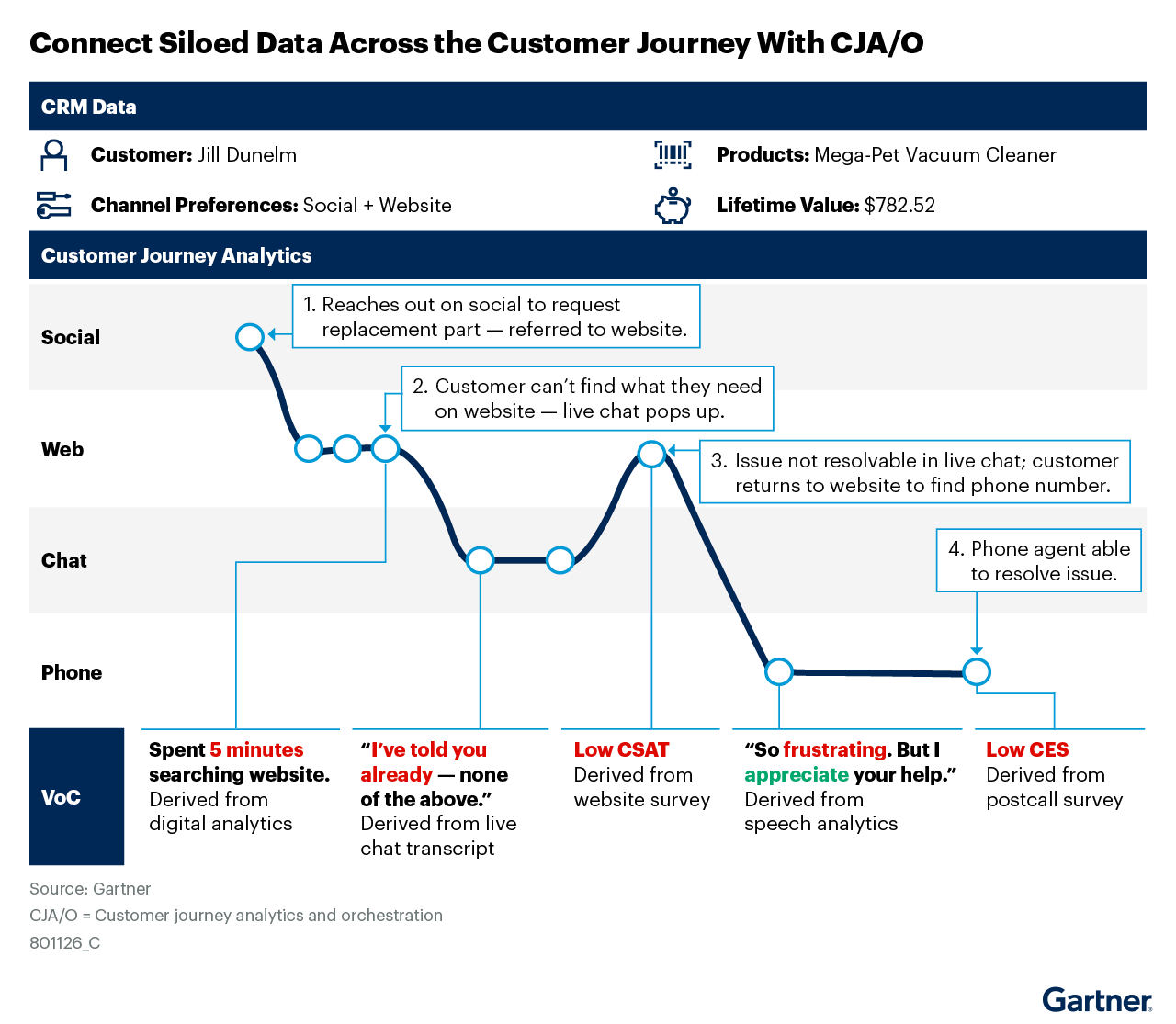Looking to improve customer experience and business outcomes?
Customer journey analytics and orchestration (CJA/O) are must-have capabilities for that—as many businesses are recognizing. The customer journey management market is surging as businesses prioritize real-time, data-driven engagement to deliver the personalized experiences today’s customers expect. According to Gartner, “Adoption of customer journey analytics and orchestration (CJA/O) technologies is increasing, as functional leaders are concerned with the impact multichannel journeys have on customer experience (CX), growth and cost reduction objectives.”
Evaluating CJA&O solutions can be time intensive, and choosing the right one in the complex customer journey orchestration market can be tricky. That’s why many buyers rely on expert research and analysis. The 2025 Gartner ® Market Guide for Customer Journey Analytics & Orchestration provides in-depth research, market analysis, expert recommendations and detailed vendor profiles to help inform smarter purchasing decisions.
Keep reading to discover our four main takeaways from this year’s report. Before we dive in, we’ll lay the groundwork by defining CJA/O and who’s using it.
What Are Customer Journey Analytics and Orchestration?
Gartner defines customer journey analytics and orchestration (CJA/O) as “solutions that track and analyze how customers and prospects interact with an organization across multiple channels over time. Most CJA/O solutions subsequently enable organizations to prioritize and orchestrate real-time improvements to the customer experience in multichannel journeys throughout the end-to-end customer life cycle.”
CJA/O solutions support three main use cases:
- Analysis—understanding complex multichannel journeys, visualizing common journeys using Sankey diagrams and journey maps
- Prioritization—using insights to prioritize design/process changes and decisions, accessing immediate feedback regarding the impact of those decisions and changes
- Orchestration—designing next best actions to orchestrate customer journeys in real time, optimizing individual journeys to deliver the best outcome for the customer and the business)
Who’s Using CJA/O Solutions? And to Do What?
According to Gartner, “Sixty-five percent of senior marketing leaders report adopting CJA/O tools, though leaders report, on average, utilizing only 43% of available capabilities. This suggests that they are not fully realizing the value of the technology.”
CJA/O systems connect event data from siloed systems and channels to help visualize customer journeys, tracking customer interactions across channels (see figure below). Overlaying voice of the customer (VoC), customer profile and transactional data provides more insight, such as customer sentiment. In this example, CJA reveals that Jill couldn’t get the information she needed from the website and live chat—and she felt frustrated and dissatisfied until the phone agent assisted her.

Customer journey orchestration systems intervene in real time with deliver treatments (or prevent harmful treatments) to improve CX. The CJO system directs Jill to the right phone agent and provides the contextual information (such as purchase and interaction history) the agent needs to assist Jill quickly, saving her from having to re-explain what she needs and decreasing call handle time.
CJA/O systems are essential tools for customer service and support technology leaders. According to Gartner, “Fifty-five percent of customer service and support leaders report doing some form of customer journey analytics. Service and support leaders anticipate that journey analytics will rise to become one of the top five most valuable technologies for their function in two years’ time.”
Our 4 Key Takeaways From the Gartner Market Guide
1. Customer journey orchestration market dynamics are shifting
Gartner says, “CJA/O is shifting from a specialist market to a capability offered within broader suites and platforms that are often industry- and domain-specific. Large vendors are integrating CJA/O capabilities into suite offerings like contact center as a service (CCaaS), personalization engines and multichannel marketing hubs and VoC platforms.”
What this means: Gartner says this shift provides buyers with more comprehensive solutions that offer increased value, simplified technology stacks, reduced integration complexity and potentially lower costs. Gartner also warns that “platforms that cater only to the needs of a single function risk perpetuating the creation of insight silos within the enterprise.”
We at CSG agree there’s a risk here—that using CJA/O that’s tied to specific functions can actually hamper the collaboration across teams that’s essential for exceptional CX.
What you can do:
Gartner’s recommendation is that businesses consider leveraging these vendors’ analytics capabilities to develop cross-functional journey insights across the end-to-end customer life cycle, with orchestration then undertaken through integrations with function-specific tools.
We believe businesses should focus on the analytics capabilities of enterprise-CX-focused vendors to develop cross-functional journey insights across the customer lifecycle. For journey orchestration, businesses should take advantage of integrations with function-specific tools, such as contact center software.
2. Generative AI Is reshaping customer journeys—and how they’re managed
Generative AI (GenAI) is transforming how customers interact with brands, frequently eliminating the need to interact with live agents altogether. Gartner notes that in the medium term, many customer journeys that take place using company-owned channels today will migrate to third-party channels. Specifically, GenAI “offers new capabilities for conversational channels and may eventually replace traditional methods of digital interaction as organizations simplify channel strategies, buoyed by improved chatbot or interactive voice response (IVR) performance.”
What this means: According to Gartner, CX leaders need to understand customer journeys that occur in third-party channels so they can help reduce customer effort and mitigate negative consequences of misinformation they might encounter in those channels.
CJA/O solutions help manage these out-of-brand journeys. One example: detecting that someone is searching Google for how to transfer data to their new smartphone, the CJO system sends a text message with a link to instructions. Gartner goes on to say: “In the longer term, conversational bots may replace some of the existing use cases and actions performed by customers on websites, in mobile apps and other channels. As a result, CJA/O solutions will need to adapt from a focus on monitoring clicks and cross-channel activity to instead monitor and intervene in conversational customer journeys.”
3. Buyers should evaluate certain factors when choosing the best-fit vendor/tools
Gartner recommends appraising vendors by considering these factors (in addition to industry and functional focus):
Approach to journey analysis: prescriptive design vs. journey discovery. With a prescriptive approach to journey analysis, users manually map out predefined journeys, and the CJA system analyzes customer progression through those predefined pathways, delivering a controlled and directed experience. This method benefits organizations with rigid parameters or regulatory constraints (e.g., banking or healthcare), where predefined paths support compliance.
Gartner explains that the journey discovery approach allows users to activate journey analytics without establishing journey maps. Instead, journeys naturally emerge through the analysis of customer activity. This method may suit organizations where customer preferences change rapidly or where journeys are highly complex and variable.
Probabilistic identity matching. This refers to using statistical methods to match individual users where reliable identifiers (e.g., a user ID) are not available. Algorithms are used to assign a likely match based on data such as location, device, user behavior and other factors. Gartner notes that probabilistic identity matching is commonly used to map journeys that span anonymous web sessions with identifiable assisted interactions. The availability of these techniques varies significantly among vendors, Gartner says.
Vendor differentiators. According to Gartner, many CJA/O capabilities touted as differentiators are commonalities across vendors, but two capabilities and four distinct vendor traits are critical in telling solutions apart and identifying the best-fit tools. Gartner provides a MUD (meaningful, unique, defensible) test in the report to help businesses determine whether a differentiator is significant enough to warrant further exploration.
4. Maximizing ROI of CJA/O tools requires a broader approach to journey management
For businesses to get the best results from CJA/O technology, Gartner says their journey management initiative should also include journey managers and teams, adapted processes such as journey mapping, and other technologies (which it references in its 2024 Strategic Roadmap for Customer Service Journey Management). Businesses should also note, according to Gartner, that cross-departmental collaboration can have a significant impact on the implementation’s success and that CJA/O solutions provide long-term benefits across many functions (e.g., service, marketing, sales, CX and digital commerce).
What you can do: Businesses can boost the ROI of customer journey management tools by “collaborating with stakeholders across functions that impact CX to define functional requirements and seek out vendors with proven experience in driving meaningful CX enhancements and business outcomes across the customer life cycle.”
We agree that type of cross-functional collaboration helps organizations get more value and output from their tech stack in general, as we highlight in the 2025 State of the Customer Experience Report. We believe businesses should choose CJA/O vendors with a proven track record of improving CX across the entire customer lifecycle—not just the point of sale.
Choose CSG Xponent for Cross-Functional Journey Insights and Orchestration
CSG Xponent—our standalone customer engagement platform, specializes in customer support and other post-acquisition touchpoints by offering journey analytics, advanced profiling, and orchestration capabilities. It also integrates with 150 platforms natively. Xponent connects systems and departments, helping organizations gain a 360-degree view of customer journeys to understand behavior, identify opportunities and drive better outcomes.
Explore the CJO/A landscape
See why CSG was recognized as a Representative Vendor by Gartner for Xponent.

Gartner, Market Guide for Customer Journey Analytics & Orchestration, Christopher Sladdin, Daniel O’Sullivan, 17 February 2025
GARTNER is a registered trademark and service mark of Gartner, Inc. and/or its affiliates in the U.S. and internationally and is used herein with permission. All rights reserved.
This graphic was published by Gartner, Inc. as part of a larger research document and should be evaluated in the context of the entire document. The Gartner document is available upon request from CSG.
Gartner does not endorse any vendor, product or service depicted in its research publications, and does not advise technology users to select only those vendors with the highest ratings or other designation. Gartner research publications consist of the opinions of Gartner’s research organization and should not be construed as statements of fact. Gartner disclaims all warranties, expressed or implied, with respect to this research, including any warranties of merchantability or fitness for a particular purpose.






